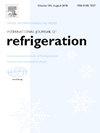Transformer-based approach to fault detection of chilled water systems: Insights from time and frequency domains
IF 3.5
2区 工程技术
Q1 ENGINEERING, MECHANICAL
International Journal of Refrigeration-revue Internationale Du Froid
Pub Date : 2025-03-03
DOI:10.1016/j.ijrefrig.2025.03.003
引用次数: 0
Abstract
The maintenance of heating, ventilation, and air conditioning (HVAC) equipment is a critical research area, particularly for anomaly detection and diagnosis in chilled water systems. While numerous methods have been proposed to achieve satisfactory detection and false alarm rates, their effectiveness in real-world environments remains limited due to challenges such as difficulty in detecting unseen anomalies, reliance on large amounts of anomalous data, and lack of adaptability to different parameter settings. To address these issues, this study focuses on identifying anomalous data by analyzing the normal operations of chilled water systems and examining their characteristics in the frequency domain over both short- and long-term periods. Based on this analysis, two distinct anomaly detection schemes are proposed: a low-frequency detection (LFD) method, which focuses on low-frequency data, and a frequency-domain segmentation detection (FDSD) method, which separately considers high- and low-frequency components. Unlike previous approaches, the proposed LFD and FDSD comprehensively integrate both time-domain and frequency-domain characteristics while determining anomaly detection thresholds without requiring anomalous data. Experimental evaluations on the ASHRAE RP-1043 dataset demonstrate that FDSD achieves a detection rate of over 90 % under varying background conditions for subtle anomalies that are typically difficult to detect. Compared to FDSD, LFD achieves a satisfactory detection rate of over 80 % while offering advantages such as shorter training time and lower model complexity.
基于变压器的冷冻水系统故障检测方法:来自时域和频域的见解
供热、通风和空调(HVAC)设备的维护是一个重要的研究领域,尤其是冷冻水系统的异常检测和诊断。虽然已经提出了许多方法来实现令人满意的检测率和误报率,但由于难以检测到未发现的异常、依赖大量异常数据以及缺乏对不同参数设置的适应性等挑战,这些方法在实际环境中的有效性仍然有限。为了解决这些问题,本研究通过分析冷冻水系统的正常运行情况,并检查其在短期和长期内的频域特征,重点识别异常数据。在此分析的基础上,提出了两种不同的异常检测方案:一种是低频检测(LFD)方法,侧重于低频数据;另一种是频域分割检测(FDSD)方法,分别考虑高频和低频成分。与以往的方法不同,所提出的 LFD 和 FDSD 全面整合了时域和频域特征,同时无需异常数据即可确定异常检测阈值。ASHRAE RP-1043 数据集的实验评估表明,在不同背景条件下,FDSD 对通常难以检测到的细微异常的检测率超过 90%。与 FDSD 相比,LFD 的检测率超过 80%,令人满意,同时还具有训练时间短、模型复杂度低等优点。
本文章由计算机程序翻译,如有差异,请以英文原文为准。
求助全文
约1分钟内获得全文
求助全文
来源期刊
CiteScore
7.30
自引率
12.80%
发文量
363
审稿时长
3.7 months
期刊介绍:
The International Journal of Refrigeration is published for the International Institute of Refrigeration (IIR) by Elsevier. It is essential reading for all those wishing to keep abreast of research and industrial news in refrigeration, air conditioning and associated fields. This is particularly important in these times of rapid introduction of alternative refrigerants and the emergence of new technology. The journal has published special issues on alternative refrigerants and novel topics in the field of boiling, condensation, heat pumps, food refrigeration, carbon dioxide, ammonia, hydrocarbons, magnetic refrigeration at room temperature, sorptive cooling, phase change materials and slurries, ejector technology, compressors, and solar cooling.
As well as original research papers the International Journal of Refrigeration also includes review articles, papers presented at IIR conferences, short reports and letters describing preliminary results and experimental details, and letters to the Editor on recent areas of discussion and controversy. Other features include forthcoming events, conference reports and book reviews.
Papers are published in either English or French with the IIR news section in both languages.

 求助内容:
求助内容: 应助结果提醒方式:
应助结果提醒方式:


